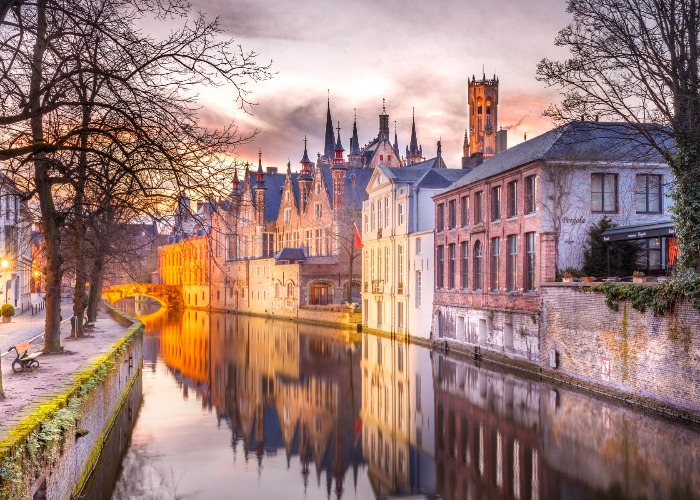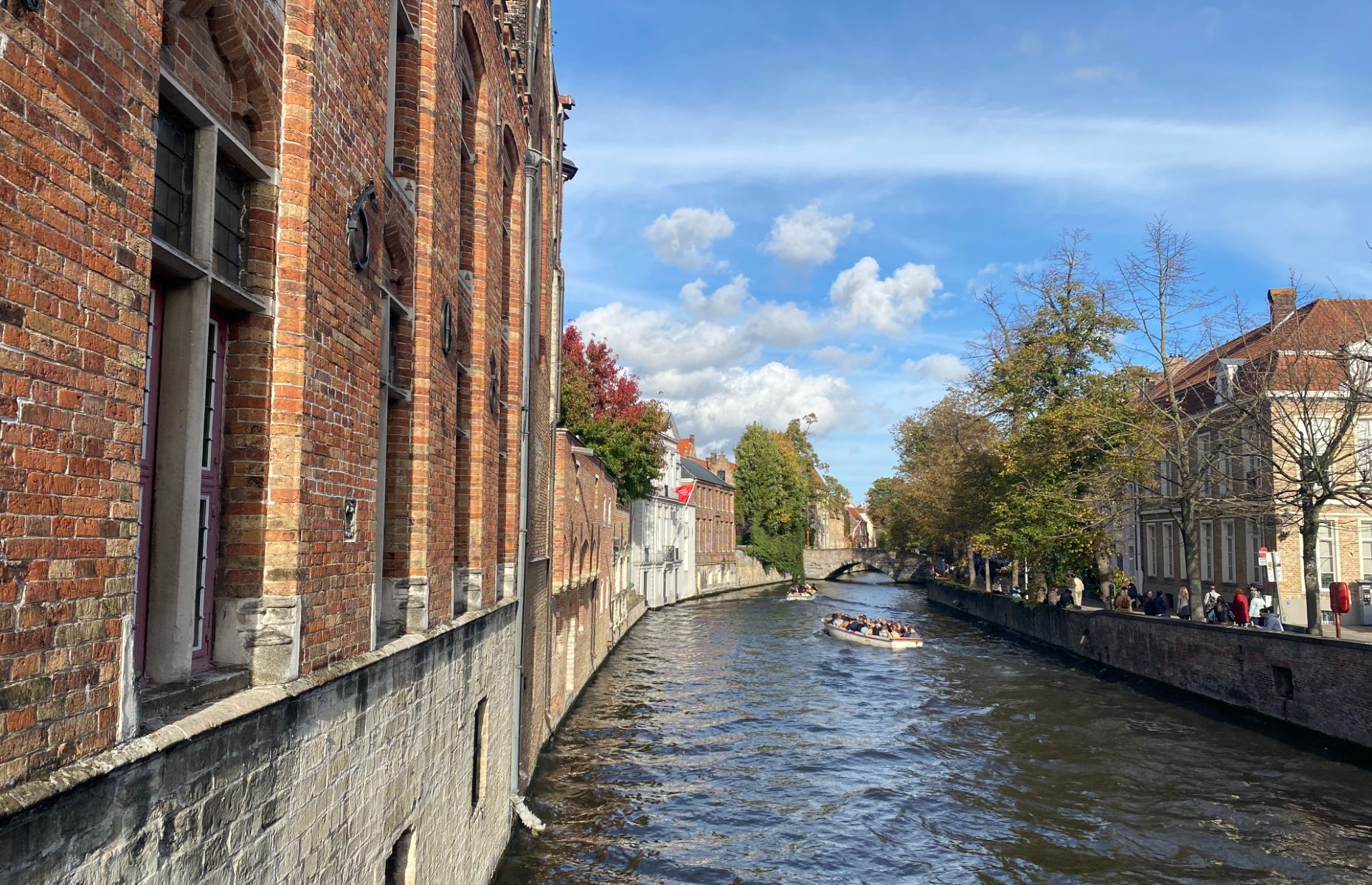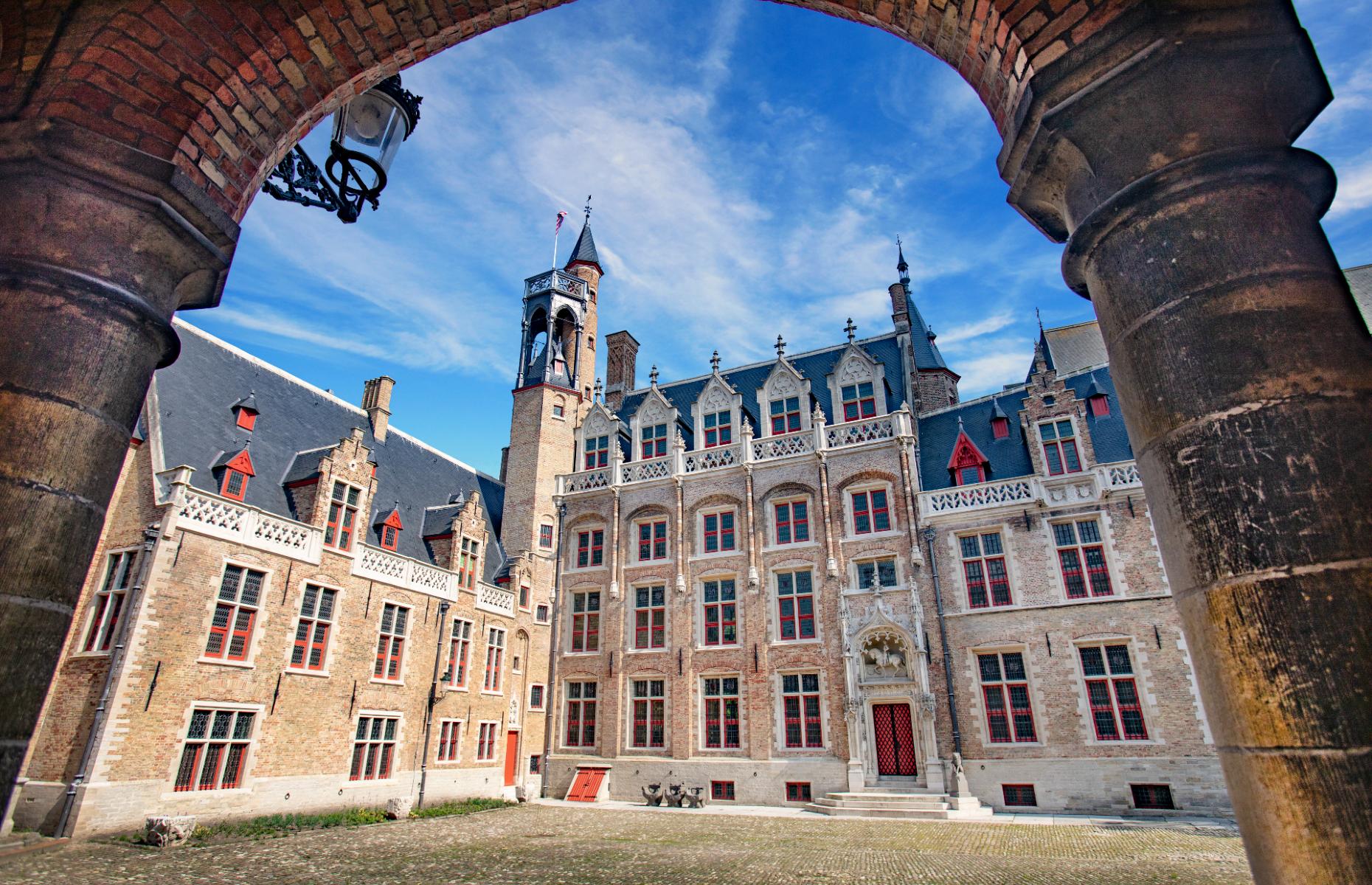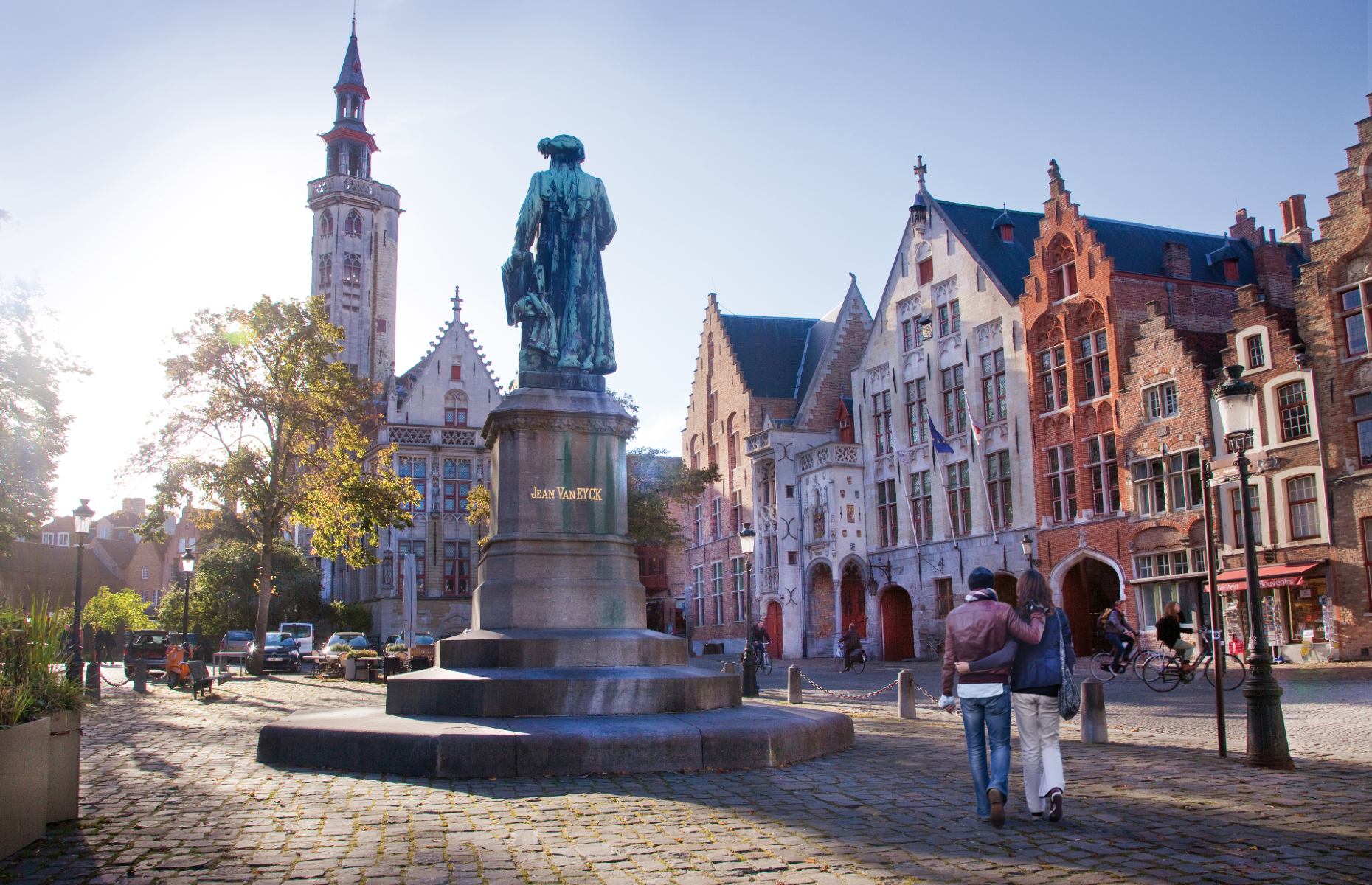48 hours in Bruges

A wintry 48 hours in pint-sized Belgian city Bruges is all about feasting on its chocolate, waffles, beer… and delightful views. Here's what to see and do in Bruges over a weekend.
Walking around Bruges in winter is as close as you can get to walking into a traditional advent calendar. Glittery lights; gilded monuments; step-gabled houses (possibly with snow-dusted rooftops); candlelit inns and glowing storefronts wafting out the scent of chocolate, sugary waffles and ‘speculoos’ (spiced biscuits).
Quaint and pretty all year round, West Flanders’ capital was the trading powerhouse of northwest Europe from the 13th to 15th century. Its storied history is palpable, from its narrow canals and little stone bridges to its Flemish art-filled galleries and brewing traditions that are as ancient as the city itself. Its cobbled lanes might be clogged with tourists but don’t let that sway you from joining the throng to see the main sights before tailing off to seek out quieter quarters.
Friday
Check into: Hotel Van Cleef. Located on the edge of the tranquil Sint-Anna Quarter, this ornate Italianate mansion oozes romance. Opt for a canal-view room to watch the boats passing by. Non-residents can also enjoy the views during afternoon tea on its waterside terrace. For a convenient and more affordable option, Hotel Le Bois de Bruges opposite 't Zand Square has good-sized rooms (including family options) and is a 10-minute stroll from the train station and the Markt (Market Square).
 AMzPhoto/Shutterstock
AMzPhoto/Shutterstock
Take a stroll: Compact and largely pedestrianised, Bruges – or Brugge as it’s known locally – is ideal for exploring on foot. Pick up a copy of the Oooh! Bruges walking guide for €3.50 at a tourist information office (there’s one at the train station, in the Concert Hall on 't Zand and in Historium on Market Square). It details four walking routes, including the Amazing World Heritage trail, which ticks off the UNESCO-listed old town’s blockbuster sights. Burg Square, the ancient seat of government, is a highlight with its ornate buildings, including the City Hall (which was built in 1376 and is one of the oldest in the Low Countries). The Basilica of the Holy Blood is said to have a relic of the blood of Jesus, awarded to the Count of Flanders after the Second Crusade in 1146.
READ MORE: Europe's top 20 cities with the best walking routes
Get a bird’s-eye-view: by climbing the city’s most prominent landmark, the Belfort – a 13th-century belfry on Market Square. You’ll need to book a time slot. The 272-foot-high (83m) bell tower has 366 steps – time your visit for the hourly chimes to hear the tower’s 47 carillon bells ring out as you gaze down at the chocolate box old town and beyond.
Taste lace-shaped waffles: After all the exertion, you deserve a treat. You have a wealth of options for sweet treats but for the city’s prettiest and most unusual waffles head to Otto Waffle Atelier next to Mariabrug. Its lace-shaped oat waffles, sprinkled with coconut blossom sugar, are a step above the standard ones – you can opt for a variety of seasonal toppings.
Admire medieval art: at the Groeninge Museum, home to work by Flemish Primitives such as Jan van Eyck, Hans Memling, Gerard David and Hieronymus Bosch. Among its most famous pieces are van Eyck’s Madonna with Canon Van der Paele and the Triptych of the Family Moreel by Memling.
Go for a beer: at Café Vlissinghe. Located in the quieter residential streets of Sint Anna, this wood-beamed building was founded in 1515, making it the city’s oldest café. It’s a wonderfully atmospheric place to sip your first Belgian beer and has an impressive selection, including local brews like Brugse Zot Blonde and Bruin. Order some classic Flemish nibbles, like cheese or shrimp-filled croquettes, to go with it.
Have dinner: at Den Gouden Karpel, a fishmonger and restaurant in the historic Vismarkt (fish market), on the east side of the canal behind Burg Square. As you’d expect in a city that’s so close to the North Sea (fishing port Zeebrugge is just 15 minutes away), the seafood in Bruges is fantastic – and you can still buy fish at the market on Wednesday to Saturday mornings. This small, smart restaurant is the place to order freshly shucked Zeeland oysters, sweet plump mussels ‘natuur’ and simply grilled catch of the day like turbot. Or try the traditional waterzooi stew, served with deliciously crunchy friet (chips).
READ MORE: 48 hours in Copenhagen
Tip: Buy a Musea Brugge Card – it costs €32 for anyone aged 26 and above or €28 for 13 to 25-year-olds. It offers free entry to the city museums for 72 hours – the Belfry incurs an extra but reduced fee.
Saturday
Go for breakfast: at That’s Toast on Dweersstraat. Don’t let the queue to this hip all-day brekkie spot put you off – it moves quickly and it’s worth the wait. Expect good coffee and all sorts of tasty things on toast. Stick to the classic all-day meat or veggie breakfast for a heaving plate that includes organic eggs and a good sprinkle of greens for goodness. The triple French toast with matcha white chocolate and berries is pretty special too.
Take a boat trip: Head to one of the five jetties in the centre to take a boat tour of the canals – the 30-minute trips take passengers along the arteries of the old trading city between Jan van Eyck Square and the Beguinage. They all take the same route and are the same price. You’ll sail past the vast 12th-century Sint-Janshospitaal (St John’s Hospital) and under some of Bruges’ 80 bridges, including the oldest (the Augustijnenbrug, built in 1391) and the picturesque Lover’s Bridge at Minnewater (Lake of Love). Tours are weather-dependent in winter. Another charming way to see the city is on a horse-drawn carriage ride, departing from Market Square. Clip-clopping around the narrow streets at a pace is quite a thrill.
 Rachel Truman
Rachel Truman
Explore the market: Every Saturday morning stalls are set up on the Zand Square selling everything from clothes and plants to grilled sausages and Belgian meats and cheeses. Buy some tasty bits for a picnic. Missed the market? Tiny deli Diksmuids Boterhuis on nearby Geldmuntstraat is a gourmand’s delight.
Tip: In Bruges midweek? There is an excellent food market every Wednesday morning in Market Square, where fresh produce from the region is sold. Grab some cold cuts and cheese or a hot rotisserie chicken – possibly with a portion of friets from the frietkotjes (small cabins) on the square. Venture up Breidelstraat to Burg Square to picnic – pull up one of the green chairs into a sunny spot. For a greener space, walk to Koningin Astridpark, a small park with tree-lined walkways and an ornamental pond. It also has a good playground for little ones.
Peek at the Madonna: The tall, 13th-century gothic Onze-Lieve-Vrouwekerk (Church of Our Lady) on Mariastraat is home to one of the city’s most prized treasures, a marble sculpture of the Madonna and Child by Michelangelo – his only work to have left Italy. It’s also home to the tombs of Charles the Bold, who controlled much of Western Europe in the 15th century, and Maria of Burgundy. Head into the Gruuthuse Museum next door, the former palace of the city lords, to learn more about Burgundian Bruges. It’s filled with artefacts, artwork and treasures from when Bruges was under the rule of the Dukes of Burgundy in the 15th century. A highlight is the wooden oratory that adjoins the Church of Our Lady and allowed the lords to watch the congregation in privacy and comfort.
 Jan D'Hondt/Toerisme Brugge
Jan D'Hondt/Toerisme Brugge
Step back in time: at Historium on Market Square. Don your VR goggles and you’ll be transported to medieval Bruges with a short but evocative virtual experience that brings its Golden Age to life. You’ll learn the building sits on the site of the old Waterhalle, a vast warehouse central to the thriving trading city that was demolished in the 18th century. Visitors wear earphones to follow an audio-visual adventure centred around Jan van Eyck’s Virgin and Child with Canon van der Paele. The imagined story behind the painting’s creation takes you through several historically themed rooms with film, music and special effects. After, climb the tower for one of the best 360° outlooks of the city and photo ops of the Belfry. Refresh with a glass of Duvel beer at the Flemish brewer’s Duvelorium Grand Beer Café on the first floor – drinking in more views over the square.
 Jan D'Hondt/Toerisme Brugge
Jan D'Hondt/Toerisme Brugge
READ MORE: The 15 best winter destinations in Europe
Go for dinner: at Brasserie Raymond, on Eiermarkt, a small square located just behind the more lacklustre restaurants of Market Square. Book in advance to bag a table at this bustling Bruges institution, with its wood panelling, mirrors and red banquettes. The menu has all the French and Belgian classics – from shrimp croquettes and vol-au-vent with sweetbreads to seafood platters, bouillabaisse and chateaubriand. Portions are generous but don’t miss the excellent desserts.
Finish with a cocktail: at Groot Vlaenderen, a lovely late-night cocktail bar on Vlamingstraat. The poky Paloma or I Am Groot should round off the evening nicely.
Sunday
Grab brekkie to go: at Aux Merveilleux de Fred on Eiermarkt. The Belgian brioche buns (cramique) are made traditionally in-store – you can watch the pastry chefs at work. Try raisin and sugar pearls, chocolate or plain. Make a mental note to return later for French pastry chef Frédéric Vaucamps’s signature ‘merveilleux’ (meringue-based cakes).
Discover the history of chocolate: at the interactive Choco-Story, The Chocolate Museum. Housed inside a handsome 15th-century building that was originally a wine tavern, this museum traces the history of the world’s best-loved confection over 4,000 years from its origins as a bitter spiced brew favoured by the Maya to the invention of the Belgian praline in 1912...and beyond. After following the audio guide through the exhibits, you can watch a chocolate-making demonstration and (best of all) help yourself to white, caramel, milk and dark chocolate buttons from the glass jars. If you’re more interested in Bruge’s ancient crafts, visit the Kantcentrum (Lace Centre) in the Balstraat. It gives a surprisingly fascinating insight into the city’s age-old lace-making tradition.
Cycle around the ramparts: and work off some of that morning indulgence. Hire a bike and follow the peaceful cycle path along the Vesten, the old city ramparts that are now a belt of green parks encircling the city. The easy and pleasingly circular four-mile (7km) ride takes you past four medieval city gates, once part of its defensive belt, and four remaining windmills. Or follow the canalside road to Damme, a picturesque neighbouring medieval port.
Watch beer being made: at the 16th-century De Haalve Maan on Het Walplein – it’s where the only beer that’s still brewed in central Bruges is made. The brewery has been run by the Maes family since 1856 and makes Brugse Zot, Straffe Hendrik and Blanche de Bruges. Today an innovative two-mile (3.3km) underground pipeline connects the brewery in the historical centre to its bottling plant just outside the city. Make straight for the firelit bar for a glass or take a tour of the brewing hall. The food is pretty good too: start with plates of local cheese and Flemish cold cuts then warm up with a hearty beef stew made with Brugse Zot Dubbel and served with fries.
Stock up on sweet treats: at The Chocolate Line, Bruges’s fanciest chocolate shop. Dominique Persoone’s avant-garde creations and creative window displays entice the crowds. He was named chocolatier of the year by Gault & Millau. Some of his most striking treats include the brightly-coloured Chill Pill (grass, yuzu and green apple) and Tiger Mango (white chocolate, mango, yoghurt and cardamom). The family-run chocolatier has its own ethical chocolate plantation in Yucatán, Mexico. Elisabeth Chocolatier on Market Square also has some exquisite creations. For ‘speculoos’ (spiced gingerbread biscuits traditionally eaten on St Nicholas Day), and slices of artisanal marzipan, pop into Brown Sugar – it has stores on both Mariastraat and Breidelstraat.
Have one more beer (and a bowl of moules) for the road: at Brasserie Brugge die Scone on Rozenhoedkaai. It has one of the most famous views of the city – a gorgeous lookout of the Belfort reflected in the canal.
Top tip: If you’re in town from late November until early January, you’ll be there for the city’s Wintergloed (Winter Glow) festival. Expect ice skating, pop-up winter bars, Christmas markets and decorations galore along with the atmospheric illuminations of the Light Experience Trail.
Getting there
Eurostar goes from London St Pancras to Brussels where you can change to a train to Bruges. Tickets are valid to/from any Belgian station at no extra cost.
For more information on Bruges, see visitbruges.be.
READ MORE: Europe's design capital: six reasons to visit sunny Valencia
Comments
Be the first to comment
Do you want to comment on this article? You need to be signed in for this feature